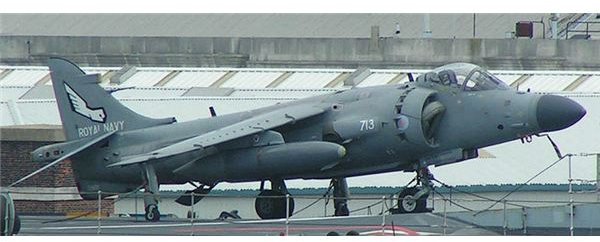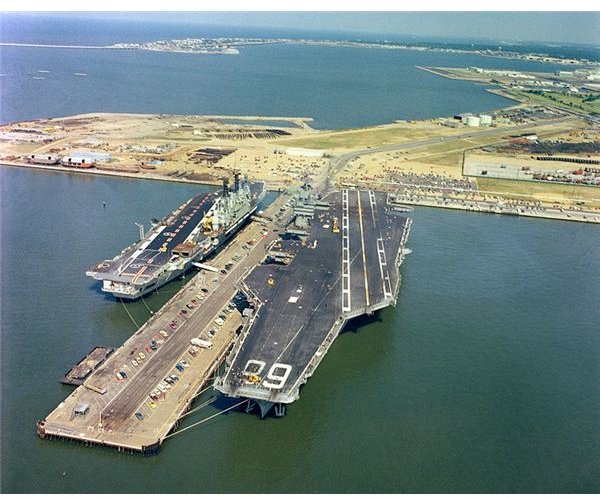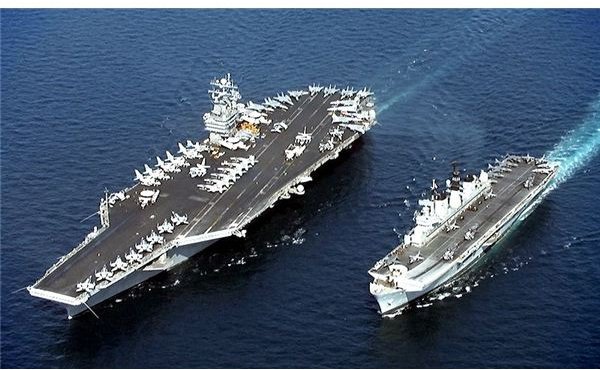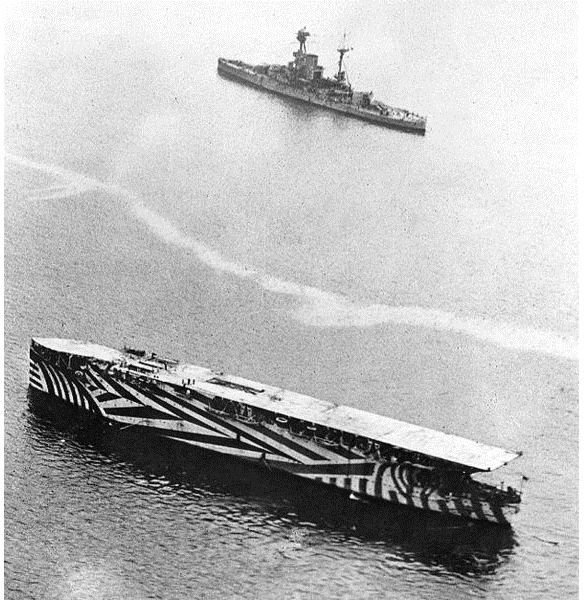New British Aircraft Carriers: The Queen Elizabeth Class
The State of Carrier Aviation in the 21st Century
Aircraft carriers have been the heart of major naval powers for over 70 years, dating from 1940-1941 when British carriers ambushed major elements of the Italian Royal Navy at Taranto and the Japanese Navy bushwhacked the US Navy at Pearl Harbor. In the 21st century the United States Navy is the clear leader in carrier aviation with eleven nuclear powered super carriers at its disposal. But it is not alone in operating carriers, whether conventional or nuclear: France, Russia, India and Brazil all operate carriers that can launch and recover fixed wing aircraft. In addition Britain, Spain, Italy, Japan, Thailand have VTOL carriers of various sizes capable of operating jump jet aircraft and helicopters.
And in the near future the list is set to expand. Future Chinese aircraft carriers are near arrival with the refurbished Varyag (renamed Shi Lang) to be re-launched in 2011 and unknown numbers of additional aircraft carriers of an indigenous design expected to follow. Current carrier operators are updating or expanding their fleets, particularly the United States, India, Russia, France, and Britain. Of the group, Chinese and British efforts constitute the most radical departures from recent decades.
While China has never before operated carriers, Britain was at the forefront of carrier development in its early years. HMS Argus was the first carrier in the world with a full length flight deck and HMS Hermes was the first vessel designed from the keel up as an aircraft carrier. But after the breakup of the British Empire the lead in carrier development fell to the United States Navy, and by 1979 Britain had retired its last carrier capable of operating fixed wing, catapult launched aircraft - the HMS Ark Royal. Filling her place were the three Invincible class carriers, effectively large helicopter carriers that could additionally operate Harrier jump jets. Until 2020 with the arrival of the new British aircraft carriers HMS Queen Elizabeth and HMS Prince of Wales Britain will actually operate only two helicopter carriers bereft even of their Harriers.
The Experience of the War Over the Falklands
By 1980 Britain’s primary role at sea was to aid in the protection of REFORGER convoys as they reinforced NATO armies in the event of a Warsaw Pact attack towards the Rhine. It was anticipated that Soviet submarines and even surface ships would push into the Atlantic Sea lanes to try and stop the convoys as they brought equipment from North America, and the Royal Navy was tasked with blocking the movement of Soviet vessels through the GIUK gap and hunting down submarines that slipped through. The HMS Invincible, HMS Illustrious, and HMS Ark Royal were well suited to this task and would likely have played a key role in any conflict at sea.
But Britain’s Cold War challenge came not from the growing Soviet Navy, but from distant Argentina. In the early 1980’s Argentina seized the British controlled Falkland Islands, which had been occupied by Britain for decades and was a legacy of its colonial empire. Located thousands of miles from Britain and mere hundreds from Argentina, Britain’s operation to retclaim the Falklands was a dangerous affair and the lack of an aircraft carrier with a dedicated wing of fighters and strike craft made conducting operations to retake the sheep and penguin filled islands difficult at best.
The war at sea was bloody, and while the British eventually emerged victorious it was not without humiliating losses. Two destroyers and two frigates were sunk by Argentine air attacks using Exocet missiles and iron bombs and several transport ships were lost as well. The British Sea

Harrier force operating off HMS Invincible was a potent defense against Argentinean raids launched in daylight and demonstrated that the friendly air cover provided by aircraft carriers made a huge difference in the course of a modern military campaign. Their weakness was in their limited range, avionics, and offensive armament - Harriers were capable fighters but lacked the technological sophistication in air to air battles possessed by contemporary US naval fighters like the F-14 Tomcat.
By the time the Falklands campaign was over the value of carriers to the fleet was clear. But although the Harrier complements were boosted on the small British carriers and their striking power improved, it was clear that the next generation of new British carriers needed to be different.
Future British Carriers - In Development Since the Late 90’s
By the late 1990’s the current British carrier fleet was reaching the end of its life, and although the Cold War was now seven years gone Britain’s defense obligations abroad were perhaps more dependent on her carriers than ever before.

The 1998 defense review made it clear that Britain would need a new generation of larger carriers of a more traditional type. Initially a joint French-British project was considered but this idea fell through rather quickly, leaving Britain to put together a design to meets its needs alone. The result: The Queen Elizabeth class carriers.
Two are under construction as of 2011 and are to be named the HMS Queen Elizabeth and HMS Prince of Wales. Their size is considerable - they will weigh in at over seventy thousand tons when fully loaded and operate an air wing of at least 36 fixed wing fighter aircraft - a strike group that rivals that carried by the larger US carriers. They are to be over 930 feet long and 240 feet abeam at the widest part of the flight deck. They will be conventionally powered and have a top speed of at least 25 knots. A 10,000 nautical mile range will give them the ability to circumnavigate the globe with but a few at sea refueling and they will be crewed by as few as 600 sailors (or as many as 1500 under wartime conditions). Point defenses will be comprised of automated phalanx Gatling gun systems and 30mm auto cannons to knock down missiles and in all likelihood a point defense surface to air missile system will be added at some point.
The air wing of the new British carriers of the Queen Elizabeth class has had a more diverse development history than the main features of the carriers themselves. Originally, it was thought that a navalized Eurofighter or the French Rafale M might be used as the multi-role core of the air wing, or possibly even the F-18E/F Super Hornet that was coming into American service in the early 2000s. Eventually it was decided that Britain would participate in the Joint Strike Fighter project and acquire the F-35B variant desired by the US Marine Corps as a replacement for its own Harrier fleet. However, issues with the ballooning cost of the F-35B and its rumored poor performance made it a less attractive proposition by 2010. At a time when the F-35B was rumored to be on the chopping block entirely, Britain publicly switched to the F-35C variant under development to meet the US Navy’s needs and to install an electromagnetic catapult system into the Queen Elizabeth class carriers. This would raise the initial cost of construction but hopefully reduce the operational costs of the air wing in the long term.
Future of the Queen Elizabeth Class in an Era of Defense Cuts
The Queen Elizabeth class carriers are expected to arrive in 2020 beginning with the namesake of the class herself, HMS Queen Elizabeth. She will replace the last of the Invincible class carriers still in operation - HMS Illustrious - and provide the Royal Navy with a striking power the likes of which it has not possessed since 1979.
It is likely that the carrier will be employed in conjunction with US and NATO vessels abroad in roles akin to those currently filled by the US

carrier fleet and the French carrier Charles De Gaulle. This means that in any future operation similar to that being waged against the Libyan regime in 2011 or the one launched against Iraq in 2003 could feature the HMS Queen Elizabeth in a key role.
The fate of the HMS Prince of Wales, however, is less clear. Because of the major budget cuts required of the British military in the wake of the 2008 financial collapse, it was determined that the second of the new British aircraft carriers would be kept in a status of “readiness”. Potentially the HMS Prince of Wales would languish without catapult systems installed or potentially even be sold off. Britain would retain only a single carrier for contingency operations, meaning that its availability would be limited. While very possibly a necessary budgetary measure it makes it appear that Britain maintains a carrier fleet more out of national pride than out of any particular strategic logic.
But a lot can happen in ten years, and budgets or an emerging naval threat may lead to the Queen Elizabeth class carriers sailing side by side into the Atlantic. No matter their final disposition, they are the cutting edge of British carrier technology and carry on the near century long legacy of Royal Navy innovations in aircraft carriers and naval aviation.
Sources:
1998 UK Strategic Defense Review
2010 UK Strategic Defense and Security Review
A Wordsworth Colour Guide Modern Warships; 1993 Wordswordh Editions LTD
Images: Courtesy of US Navy, Odessa3, US Navy, and Robert Baker of the US Navy respectively.
